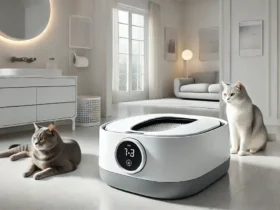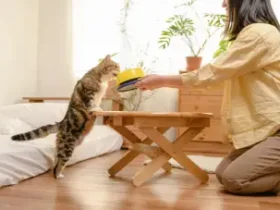Introduction
As a cat owner, maintaining a clean litter box is one of the most crucial parts of pet care. The question, “How often to clean a cat litter box,” might seem easy to clean, but various factors can play an important part in the frequency of cleaning. A clean and fresh litter box is important for your cat’s health, prevents bad smell buildup in your house, and ensures your pet friend continues to use the litter box. In this guide, we’ll explain how often to scoop, replace, and deep clean your cat’s litter box while providing useful tips to make the process easier. Follow this guideline to deeply clean your litter box and make your cat happy and healthy.
Why Is Cleaning a Cat Litter Box Important?
Health Benefits for Your Cat
A dirty, uncleaned litter box can become a breeding ground for harmful bacteria, germs, and parasites. Regular cleaning helps prevent infections like urinary tract infections (UTIs), skin diseases, and parasitic infestations, keeping your cat clean, healthy, and comfortable.
Odor Control in Your Home
Nobody likes a bad smelly house. Regularly cleaning the litter box ensures that unpleasant odors don’t linger. This not only benefits you but also provides a more pleasant environment for your feline friend. So regular cleaning is essential for the cat and the owner also.
Preventing Behavioral Issues
Cats are notoriously clean animals by born. If their litter box is dirty, they would never use it, leading to accidents around your house. Regular cleaning helps avoid this behavior and keeps your cat stress and anxiety-free.
Factors That Affect Litter Box Cleaning Frequency
Number of Cats: If you have more than one cat, your cat produces more waste, which can quickly lead to unpleasant odors and an unclean environment.
Single Cat Household: Scoop the waste daily and replace litter weekly.
Multiple Cat Household: Scoop at least twice a day and change the litter twice a week. The cleaning process helps your cat to used to with litter box.
Type of Litter
The type of litter that you use forces how often you need to clean the litter box. Common types of litter include:
Clumping Litter: Forms solid clumps when wet by urine, making daily scooping easy. This type of litter needs a full change every 1 or 2 weeks.
Non-Clumping Litter: Absorbs moisture but doesn’t form clumps. This type requires full replacement every 3-5 days. Some cats like to use non-clumping litter.
Silica Gel Litter: Absorbs moisture and controls bad smell effectively. Replace this litter every 2-4 weeks, but scoop solids daily.
Type of Litter Box
Different types of litter boxes require different cleaning frequencies:
Open Litter Boxes: Easier to maintain and clean but expose odors more readily. But some cats prefer this type of box.
Covered Litter Boxes: Trap odors but need more frequent cleaning due to limited ventilation. Some cats don’t prefer to use it because they think it is a trap.
Self-Cleaning Litter Boxes: Automate scooping but still require weekly cleaning and maintenance. this is a new-generation litter box.
Cat’s Age and Health
Kittens: Tend to use the litter box more often and require frequent cleaning. Because kitten gets easily affected by bacteria and germs.
Senior Cats: They may have health conditions that need to more frequent urination.
Ill Cats: Cats with urinary tract infections or diabetes may need more frequent litter box cleaning.
Why Daily Scooping is Important
Scooping the litter box at least once a day is the golden rule for maintaining a clean environment and fresh, odor-free air. Daily scooping helps:
Prevent Odor Buildup: Removing waste daily minimizes unpleasant smells from the house.
Promote Good Hygiene: A clean litter box reduces bacteria, germs, and parasites.
Monitor Cat Health: Regular cleaning helps you spot any changes in your cat’s waste, which could indicate health issues for your cat.
Signs You Should Scoop More Often
- Persistent odors even after scooping the waste.
- Your cat avoids the litter box to use.
- Visible waste clumps that weren’t removed previously
For multiple cats, consider scooping twice a day to maintain cleanliness and freshness.
How Often to Replace Cat Litter Completely
Weekly Replacement Guidelines
Even if you scoop daily, the litter box needs a full change to maintain hygiene. A general rule is:
Clumping Litter: Replace completely every 1 or 2 weeks.
Non-Clumping Litter: Replace every 3 or 5 days.
Silica Gel Litter: Replace every 2 or 4 weeks.
Signs It’s Time for a Complete Change Your Litter Box
Strong Odors: Lingering bad smell even after scooping.
Discoloration: Litter appears dark or dirty even after a deep clean.
Wet Spots: Persistent wet patches that don’t clump or remove.
Cat’s Behavior: Your cat hesitates or refuses to use the litter box.
How Often to Deep Clean the Litter Box
Monthly Deep Cleaning Routine
A deep cleaning of your cat’s litter box should be done at least once a month. This involves scrubbing the entire box to remove bacteria and odor buildup. Use germ or bacteria-killed soap.
Step-by-Step Guide to Deep Cleaning
Empty the Box: Dispose of all litter and waste.
Scrub with Mild Soap: Use warm water and mild, unscented soap. Avoid bleach or ammonia, as these can harm your cat. And scrub gently.
Rinse Thoroughly: Ensure all soap residue is removed from the litter box.
Dry Completely: Let the box air dry or dry with a towel. You can dry it with sunlight.
Refill with Fresh Litter in Box: Add 2-3 inches of new litter in your litter box.
Bonus Tip:
Consider using baking soda on the bottom of the box before adding litter for extra odor control. Wash your hands with germ and bacteria-free soap.
Tips for Reducing Litter Box Odors
Use Odor-Control Litter: Consider clumping or silica gel litter for your cat.
Add Baking Soda: Sprinkle a thin layer at the bottom of the box which will help to prevent germs and bad odor.
Proper Placement: Place the litter box in a well-ventilated area so that bad smell would not form.
Activated Charcoal Filters: Use filters to absorb odors in covered litter boxes which will be helpful for your cat’s using litter boxes.
Common Mistakes in Litter Box Maintenance
Using Harsh Cleaners: Avoid bleach or ammonia-based products to clean the box.
Not Cleaning Frequently Enough: Irregular cleaning leads to odors and health risks for your cat.
Overfilling the Box: 2-3 inches of litter is ideal, too much litter can lead to tracking issues for your cat.
Ignoring the Box Location: Place the litter box in a quiet, accessible area and traffic-free area.
Maintaining Multiple Litter Boxes for Multiple Cats
The Rule of “One Box Per Cat Plus One” is given here: if you have multiple cats in your house, my recommendation is the number of litter boxes is one per cat plus one extra. For example:
2 Cats Need: 3 Litter Boxes
3 Cats Need: 4 Litter Boxes
Tips for Multiple Litter Boxes
Spread Them Out: Place boxes in different locations of your house to prevent territorial issues.
Clean Regularly: Scoop your litter twice a day and replace the whole litter weekly in the box.
Monitor Behavior: Ensure each cat is using the boxes comfortably. Otherwise, they will not use the litter box.
Conclusion
Knowing how often to clean a cat litter box is crucial for maintaining your cat’s health, and comfort and ensuring a pleasant house environment. By scooping daily, changing litter weekly, and deep cleaning monthly, you can provide a clean and odor-free environment for your pet friend. If you follow these guidelines to keep your cat happy, and healthy, they will use their litter box regularly.
FAQs
1. How often should I clean the litter box for one cat?
Scoop your litter box twice a day and change the whole litter once a week for better result. Which will be healthier for your cat.
2. Can I use scented litter to control odor?
Scented litter boxes, can be unpreferable, uncomfortable and allergic for some cats. Use unscented litter and baking soda for bad smell control.
3. How do I know if my cat is avoiding the litter box because it’s dirty?
If your cat does not use the box and eliminate the outside of the box or hesitates to use it, the box may need cleaning or changing.
4. What type of litter box is easiest to clean?
Uncovered open litter boxes are the easiest to clean and scoop daily.
5. How often should I deep clean the litter box?
You should deep clean the litter box once a month with baking soda. If it is possible deeply clean your box twice a month.





Leave a Reply